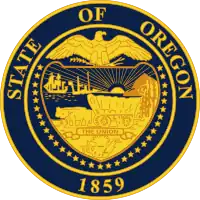| Elections in Oregon |
|---|
 |
A general election was held in the U.S. state of Oregon on November 6, 2018. Primary elections were held on May 15, 2018.
United States House of Representatives
All five of Oregon's seats in the United States House of Representatives were up for re-election in 2018. All five incumbents, four Democrats and one Republican, won re-election.[1][2]
Governor
Incumbent Democratic Governor Kate Brown was originally elevated to the role in February 2015 upon the resignation of her predecessor, Governor John Kitzhaber. Then serving as the Oregon Secretary of State, Brown was first in the line of succession to replace the Kitzhaber.[3] Brown won a special election the following year to serve the final two years of Kitzhaber's four-year term. Brown won re-election to her first full term in this election. Brown was challenged by Republican Knute Buehler, representative of Oregon's 54th House district, and several third party candidates.[4][1]
Commissioner of Labor
Incumbent Brad Avakian elected not to seek re-election to the office of Oregon Commissioner of Labor.[5] A nonpartisan primary election was held alongside partisan primary elections on May 15, 2018. Three candidates appeared on the primary election ballot:[6]
- Jack Howard, Union County Commissioner
- Val Hoyle, former Majority Leader of the Oregon House of Representatives and Representative for Oregon's 14th House district
- Lou Ogden, Mayor of Tualatin
Since the Commissioner of Labor is a nonpartisan role, a general election is only held if no one in the primary election secures 50% of the vote.[6] Hoyle avoided a runoff vote and was elected to the role by winning 52.28% of the vote in the primary election.[7]
| Party | Candidate | Votes | % | |
|---|---|---|---|---|
| Nonpartisan | Val Hoyle | 375,762 | 52.28 | |
| Nonpartisan | Lou Ogden | 253,977 | 35.34 | |
| Nonpartisan | Jack Howard | 86,477 | 12.03 | |
| write-ins | 2,520 | 0.35 | ||
| Total votes | 718,736 | 100.00 | ||
Legislative
Of the 30 seats in the Oregon State Senate, 17 were up for election (15 regular elections and 2 special elections). All 60 seats in the Oregon House of Representatives were up for election. As a result of the election, the Democratic Party expanded its advantage over the Republican Party and held a supermajority in both chambers. Democrats had an 18-12 majority in the Senate and 38-22 majority in the House of Representatives.[1][9]
Ballot measures
There were five statewide Oregon ballot measures on the general election ballot. As a result of the election, one ballot measure passed while the other four failed.[1][10][11]
| Measure | Description | Votes | |
|---|---|---|---|
| Yes | No | ||
| Measure 102 | Amends Constitution: Allows local bonds for financing affordable housing with nongovernmental entities. Requires voter approval, annual audits | 1,037,922 (56.90%) | 786,225 (43.10%) |
| Measure 103 | Amends Constitution: Prohibits taxes/fees based on transactions for "groceries" (defined) enacted or amended after September 2017 | 791,687 (42.69%) | 1,062,752 (57.31%) |
| Measure 104 | Amends Constitution: Expands (beyond taxes) application of requirement that three-fifths legislative majority approve bills raising revenue | 631,211 (34.81%) | 1,182,023 (65.19%) |
| Measure 105 | Repeals law limiting use of state/local law enforcement resources to enforce federal immigration laws | 675,389 (36.54%) | 1,172,774 (63.46%) |
| Measure 106 | Amends Constitution: Prohibits spending "public funds" (defined) directly/indirectly for "abortion" (defined); exceptions; reduces abortion access | 658,793 (35.52%) | 1,195,718 (64.48%) |
References
- 1 2 3 4 "November 6, 2018, General Election Abstract of Votes". Oregon Secretary of State. Archived from the original on April 27, 2021. Retrieved July 9, 2019.
- ↑ "Incumbent Oregon House members re-elected". Corvallis Gazette-Times. November 6, 2018. Archived from the original on November 7, 2018. Retrieved July 9, 2019.
- ↑ Jaquiss, Nigel (February 13, 2015). "Gov. John Kitzhaber Announces His Resignation". Willamette Week. Archived from the original on May 14, 2016. Retrieved July 12, 2019.
- ↑ Selsky, Andrew (November 7, 2018). "Democrat Kate Brown wins re-election as Oregon governor". AP News. Archived from the original on February 26, 2019. Retrieved July 9, 2019.
- ↑ Friedman, Gordon R. (July 11, 2017). "Brad Avakian, Oregon labor bureau chief, will not seek re-election". The Oregonian. Archived from the original on October 2, 2019. Retrieved October 1, 2019.
- 1 2 VanderHart, Dirk; Wilson, Conrad (May 14, 2018). "Oregon Voters Select Val Hoyle As New Labor Commissioner". OPB. Archived from the original on October 2, 2019. Retrieved October 1, 2019.
- ↑ Selsky, Andrew (January 7, 2019). "Oregon reaches milestone as new labor commissioner, Val Hoyle, sworn in". Statesman Journal. Archived from the original on August 6, 2023. Retrieved October 1, 2019.
- ↑ "May 15, 2018, Primary Election Abstract of Votes Commissioner of the Bureau of Labor and Industries". Oregon Secretary of State. Archived from the original on October 18, 2020. Retrieved October 1, 2019.
- ↑ Radnovich, Connor (November 6, 2018). "Oregon Democrats secure supermajorities in both chambers of Oregon Legislature". Statesman Journal. Archived from the original on March 1, 2023. Retrieved July 9, 2019.
- ↑ Borrud, Hillary (August 3, 2018). "Oregon ballot measures at 30-year low. Here's why". The Oregonian. Archived from the original on March 30, 2019. Retrieved July 12, 2019.
- ↑ "Oregon voters approve Measure 102 on affordable housing bonds, defeat other measures". KVAL. November 6, 2018. Archived from the original on September 28, 2019. Retrieved September 28, 2019.
f